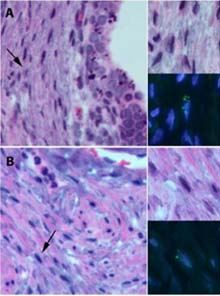Research
September 8, 2010
Detecting a mysterious retrovirus

Detecting XMRV in prostate tissue. A variety of assays (neutralizing antibodies, polymerase chain reaction or fluorescence in situ hybridization) may be used to look for XMRV
A recent research paper on XMRV, which has been linked to prostate cancer and chronic fatigue syndrome, highlights the need for a variety of laboratory tests for detecting the mysterious retrovirus.
Emory scientists have developed a test for XMRV (xenotropic murine leukemia virus-related virus) based on neutralizing antibodies, which offers an alternative to the DNA-based tests that may have caused some confusion for other researchers.
The twist from the long-delayed paper (published Aug. 23 in Proceedings of the National Academy of Sciences) is that the NIH/FDA team, led by Harvey Alter, didn’t find viruses all with the same DNA sequence in chronic fatigue patients.
Instead, they found a cluster of closely related, but different, viruses. These results may explain why tests for the presence of the virus that are based on viral DNA sequences may have generated conflicting results. An assay based on antibodies, such as John Petros and colleagues at Emory developed, may be useful because it casts a wider net.
Alongside Petros, pathologist Hinh Ly has been diving into the XMRV field, with a recent paper in Journal of Virology describing what “gateway” molecule the virus uses to sneak into cells and what kinds of cells in the prostate it can infect.
In a collaboration with Ila Singh at the University of Utah, antiviral drug expert Raymond Schinazi has found that a number of drugs active against HIV also stop XMRV. This offers some hope that if doctors can detect members of the XMRV family, and figure out what they’re up to, they might be able to combat the troublemakers as well.
Quick Links
File Options
Related Information
For more stories about health research, discovery and educational innovation, see the Woodruff Health Sciences Center's Emory Health Now blog.
